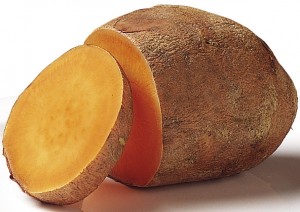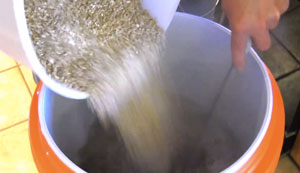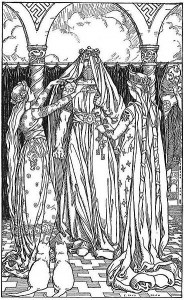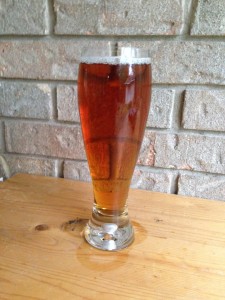
The Russian T-34 tank, one of the best all-around tanks of WWII. I think they are very fun to drive (when playing Medal of Honor on my Playstation).
(Photo from Wikipedia’s T-34 page, used under Creative Commons license.)
This is a partial mash recipe for a Russian imperial stout. The recipe will work with any partial mash method, but the procedures specifically refer to countertop partial mashing.
There are several challenges to brewing a beer this big and hoppy. One of them is that there will be a lot of break material and hop debris at the bottom of the kettle. I employ a settling stage of about two hours to let the kettle debris settle and compact a bit. (If you have a way to filter the wort, this will also work.)
The classic rookie mistake when making a big beer is to pitch an inadequate amount of yeast. For this recipe, I recommend pitching two packets of dried yeast so the fermentation will start quickly and proceed without sticking. Aerating the wort thoroughly and holding the fermentation temperature steady around 68 °F (20 °C) are the other most important factors in brewing this beer.
My procedures call for collecting the wort from the mash and holding this at 150 °F (66 °C). A little less than half of the malt extract will be in the brewpot at this point. The point of this is to let the enzymes from the mash work on the carbohydrates from the malt extract. If you follow this instruction, and pitch the amount of yeast I recommend, you should get between 75 and 80% apparent attenuation. Given the OG, this will still be a full-bodied beer. However, it will not be sweet and will instead be surprisingly quaffable for a beer of it’s size.
This beer requires some aging to come into the proper condition. However, if you pitch enough yeast and run your fermentation well, you don’t need to wait forever for it to get good. Try sampling the first beers roughly two months after your brew day. You can age of your batch for extended amount of times if you’d like. However, don’t forget to drink some of it while it’s fresh and full of hop flavor and aroma. This will decline with aging.
To brew this beer, you will need a 2-gallon (~8-L) beverage cooler with the spigot on the bottom and a steeping bag large enough to line it. You will also need a second steeping bag capable of holding 3.5 lbs. (1.6 kg) of crushed grains. Follow the instructions as closely as possible, and review the general instructions for countertop partial mashing before your brew day.
T-34 Stout
Russian Imperial Stout
Partial mash; English units
DESCRIPTION
A big (9.6% ABV), roasty, hoppy stout. This ale is very flavorful and full-bodied, but attenuated enough that it is not too sweet.










Recent Comments